Construction and design are like a good book: New chapters come alive through details. It is the details that now are turning the once dormant Louisiana Children’s Museum location in a historic and now trendy New Orleans neighborhood into a revived 120,000-sq-ft residential and social space. This chapter of the building’s story, a structure that dates to the mid-19th century, connects its historic aspects with a five-story addition now underway.
The dual components of the project, referred to as Memoir and Common House, are located on Julia Street in the city’s storied Warehouse District. Often called Gallery Row, the area is witnessing a major revitalization. The former museum structure dates to the 1840s as a private home, later serving as a warehouse operated by the Port of New Orleans.
The museum occupied the structure in 1986 but left in 2019 when the property was purchased for redevelopment, moving to a new $47.5-million campus on an 8.5-acre site in City Park.
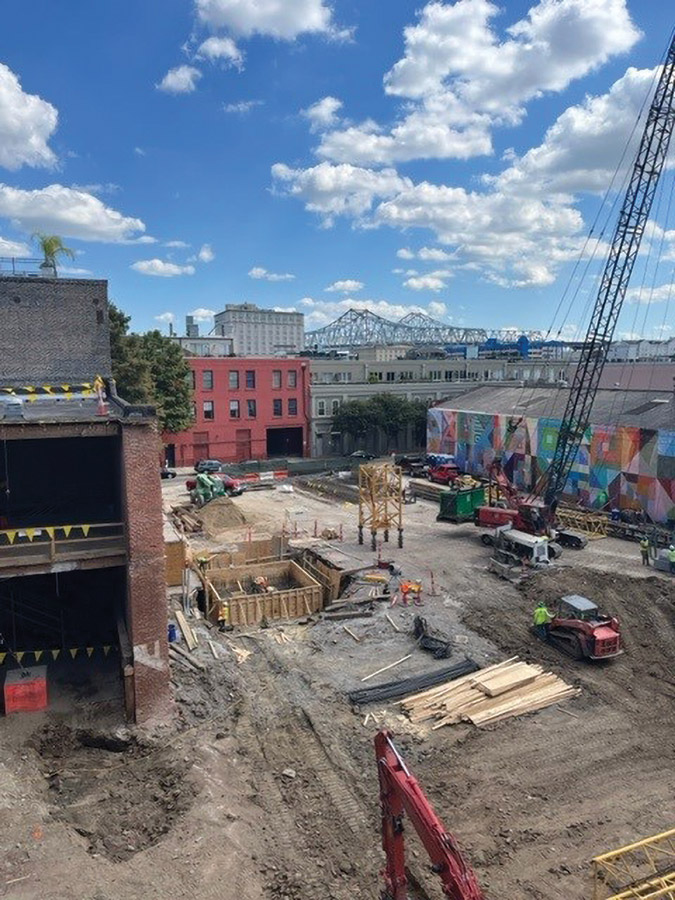
The constrained jobsite was part of a former industrial space in downtown New Orleans.
Photo courtesy RNGD
Renovation and construction began last year for a multistory building that will have 43 hotel rooms on the second floor and 70 residential apartment units on its upper floors, says Brittany Martin, senior project manager at New Orleans-based RNGD, lead contractor and design-build partner for owner 420 Julia Property Holder LLC.
A cost estimate for the project was not released.
The owner’s goal is to create “a one-of-a-kind experience” for residents and visitors in the Warehouse District and to open in time for New Orleans’ summer festival season, Martin says.
As of late February, Memoir, the 100,000-sq-ft new construction portion of hotel space and apartments, was in the punch-list phase. Common House, the 20,000-sq-ft renovation of the historic building into a private dining and entertainment space, is starting interior finishes, with the goal to complete work this summer, she says.
“The historic building’s first floor will remain largely intact while it is transformed into Common House, a modern social club,” she says. The project will blend the historical with the new by including a rooftop bar, pool and deck area, large gym and courtyard, Martin adds.
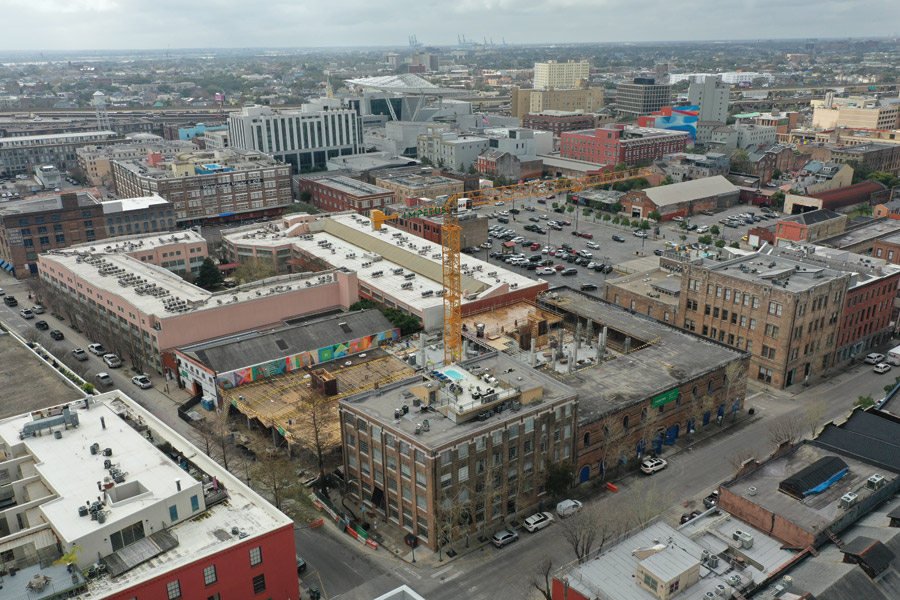
The new project is located in New Orleans’ historic Warehouse District, which is experiencing a revitalization.
Photo courtesy RNGD
RNGD work crews are following the design concept of project architect Hartshorne Plunkard Architecture and interior design firm Joshua Joseph Interiors to preserve the structure’s exterior, the former museum’s well-known blue arched doors and other unique historic features. “The blue doors are here to stay,” the interiors firm owner Josh Charles told a New Orleans business publication. He also is design and construction director of all U.S. Common House sites, according to his LinkedIn site.
Combining the old and modern was important also to RNGD as was ensuring that the first chapter of the renovation and new construction would proceed without any unexpected twists, Martin says. By creating a meticulous schedule, the contractor’s architectural fabrication division is crafting the lobby’s intricate architectural components.
While former museum entrances facing Julia and Constance streets will be preserved, “interior space was stripped down to its bare bones,” says Martin.
The contractor’s team added additional detailing and shop drawings, then transitioned into the fabrication phase. “Our deliverables included a custom white oak reception desk and square faux column cladding designed to encase the existing structural columns with an elegant covering,” she says.
Project scope also included wainscoting trim assembly and built-in bookcases that were fabricated and assembled in the RNGD workshop. The team worked on a large and demanding package that included coffered ceilings and crafting trim around prehung lobby mirrors.
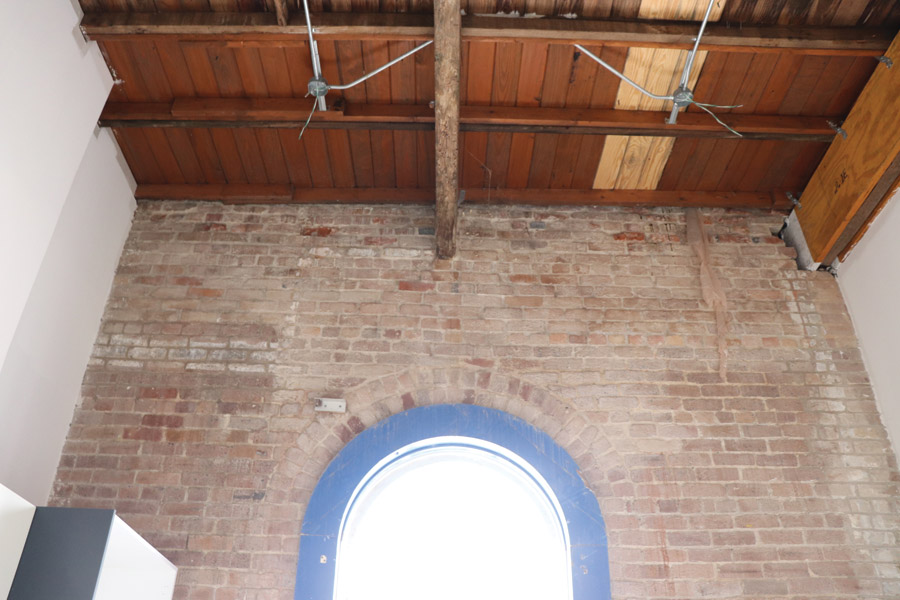
With New Orleans known for its unique history, the building aims to pay tribute to the city's style, says the developer.
Photo courtesy RNGD
The Scopes
RNGD’s building division oversaw the new construction portion of the project, while the company’s steel team played a key role in preserving the historic building’s structural integrity.
“With three scopes at play—shoring, structural and miscellaneous—the steel team undertook the complete fabrication and installation of a large steel package encompassing 235 tons of structural and miscellaneous steel,” Martin says. The project’s biggest challenge involved seamless integration of the existing historic timber structure with a modern concrete building, she adds.
“The historic building's first floor will remain intact while it is transformed into Common House, a modern social club.”
—Brittany Martin, Senior Project Manager, RNGD
“The process began with a temporary shoring package to secure the original brick structure while the back half of the building underwent demolition. Our work involved bolting steel channels through and onto the timber framing members, securing the building’s stability while a significant portion was removed,” Martin points out.
Once the historical structure was secure enough to execute the structural scope, work crews commenced filling the gaps between the wood and concrete structures with steel, “merging the two structures,” she explains.
This was achieved by coordination of resources and people. “The success of integrating a timber structure with the new concrete building hinged on a huge coordination effort that extended the project’s miscellaneous scope,” Martin says. “During the design phase, the team collaborated closely with other divisions and trades to determine the precise location of embeds in the concrete structure.”
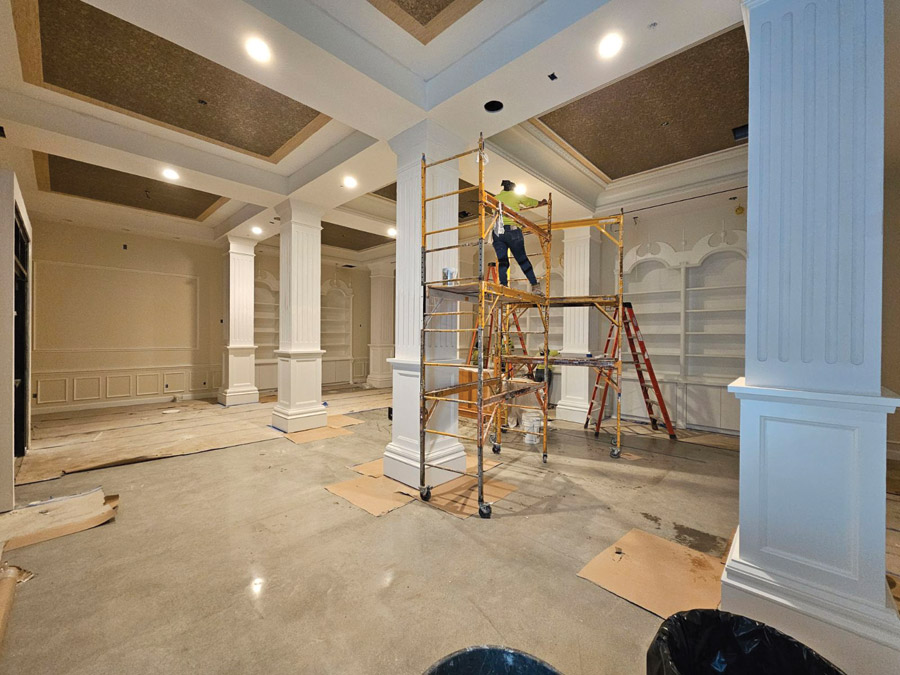
Great attention to detail was used during the design and remodeling of the lobby.
Photo courtesy RNGD
Big Issues
During the shop-drawing phase, team members encountered distinct power grid systems for the existing and the new structures. With no reference point between the two, they analyzed the steel’s placement, conducting field measurements and surveys for every component where the two buildings intersected, she says. “Ultimately, they coordinated locations and uncovered accurate identifiers that would allow them to align and connect the two grid systems.”
During the design phase, the RNGD team collaborated closely with other company divisions and trades to determine the precise location of embeds in the concrete structure.
As concrete was poured for the post-tension slab, the team provided material and information in advance, ensuring their components were integrated into the structure, she says. Any post-pour drilling would have risked damaging cables within the concrete, compromising the slab’s structural integrity.
The steel field team ensured all elements were strategically placed before the concrete pour, mitigating potential complications and upholding the work timeline.
A portion of the structure’s 47 original timber columns required steel reinforcement. The building’s brick wall facing Julia Street received internal structural reinforcement, with tie-backs through the masonry walls using plates reminiscent of historical decorative supports seen throughout New Orleans, Martin says.
“Our team also bolstered the courtyard wall on Julia Street with helical ties. We drilled long masonry screws into the brick, then installed stainless-steel rods to counteract deterioration of the aged bricks,” Martin notes.
“The exterior facade was revived as well by tuckpointing various areas of brick and removing vegetative growth,” she says. Uniform elevation and cohesiveness integration are key to using concrete with the old wood.
To head off any issues, a strip of metal decking with structural steel was installed, poured with concrete and topped with gypcrete to create a seamless monolithic floor, she says.
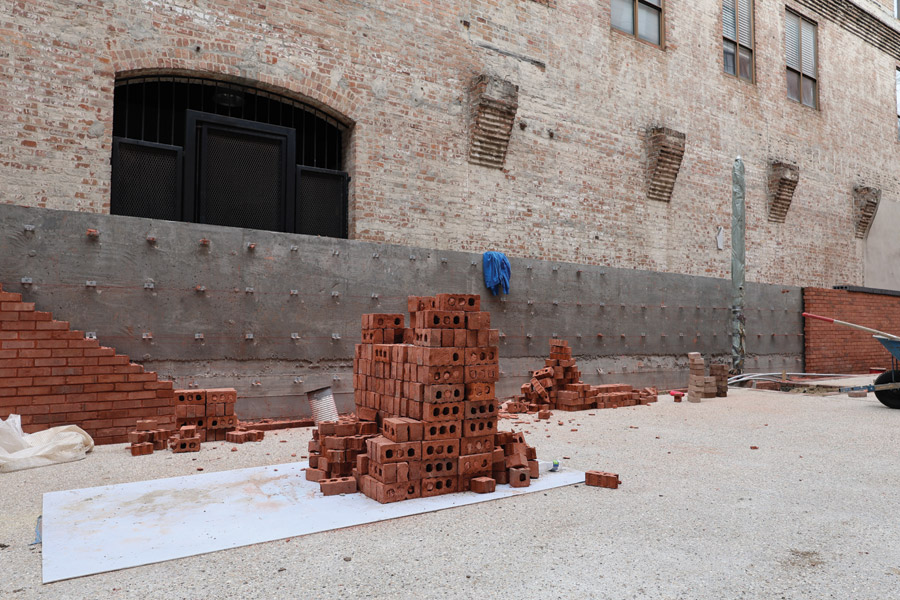
New brick will replace historic material during the renovation.
Photo courtesy RNGD
Technology Boost
Technology also has been important in the project. Work crews used TrueLook construction cameras for progress photos until the exterior skin was completed. Team members also used BIM for all coordination of in-wall and overhead rough-in scopes of work, mechanical, electrical, structural, plumbing and underground piles and pile caps, Martin says.
“This proactive coordination saves time and money for rework, [eliminating] delays while procuring items that may have clashed,” she says. The project also focused to a great extent on sustainability, which is key in restoring historical buildings, Martin says, adding that “The most significant sustainability strategy was reusing and repurposing the existing historic building rather than demolishing it and rebuilding an entirely new structure.”
RNGD, formerly called IMPETUS, won ENR Texas/Louisiana’s Project of the Year award for revamping The Carrollton, a more than 170-year-old courthouse in New Orleans converted into a senior living center. The Greek Revival landmark, which had suffered effects of time, weather and neglect, was enlarged and now includes a grand interior with elegant common spaces.
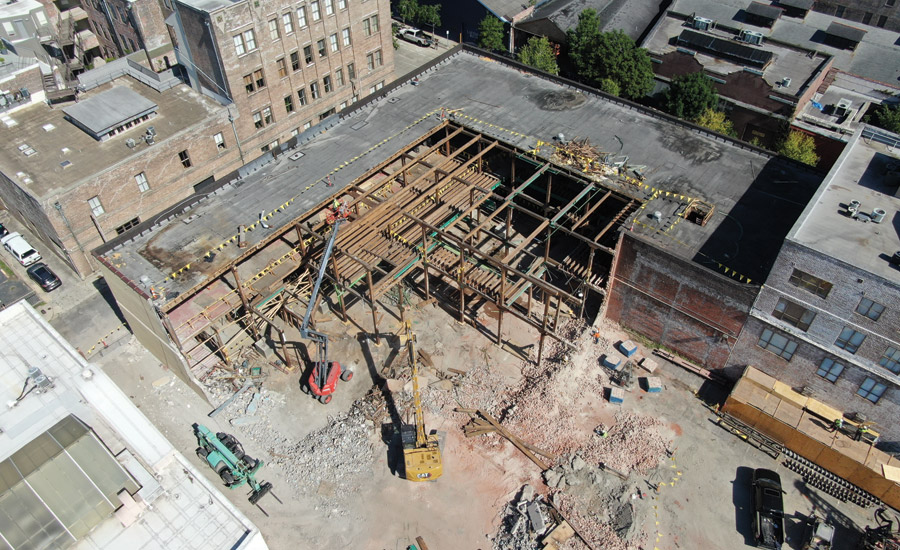


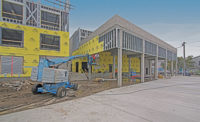

Post a comment to this article
Report Abusive Comment